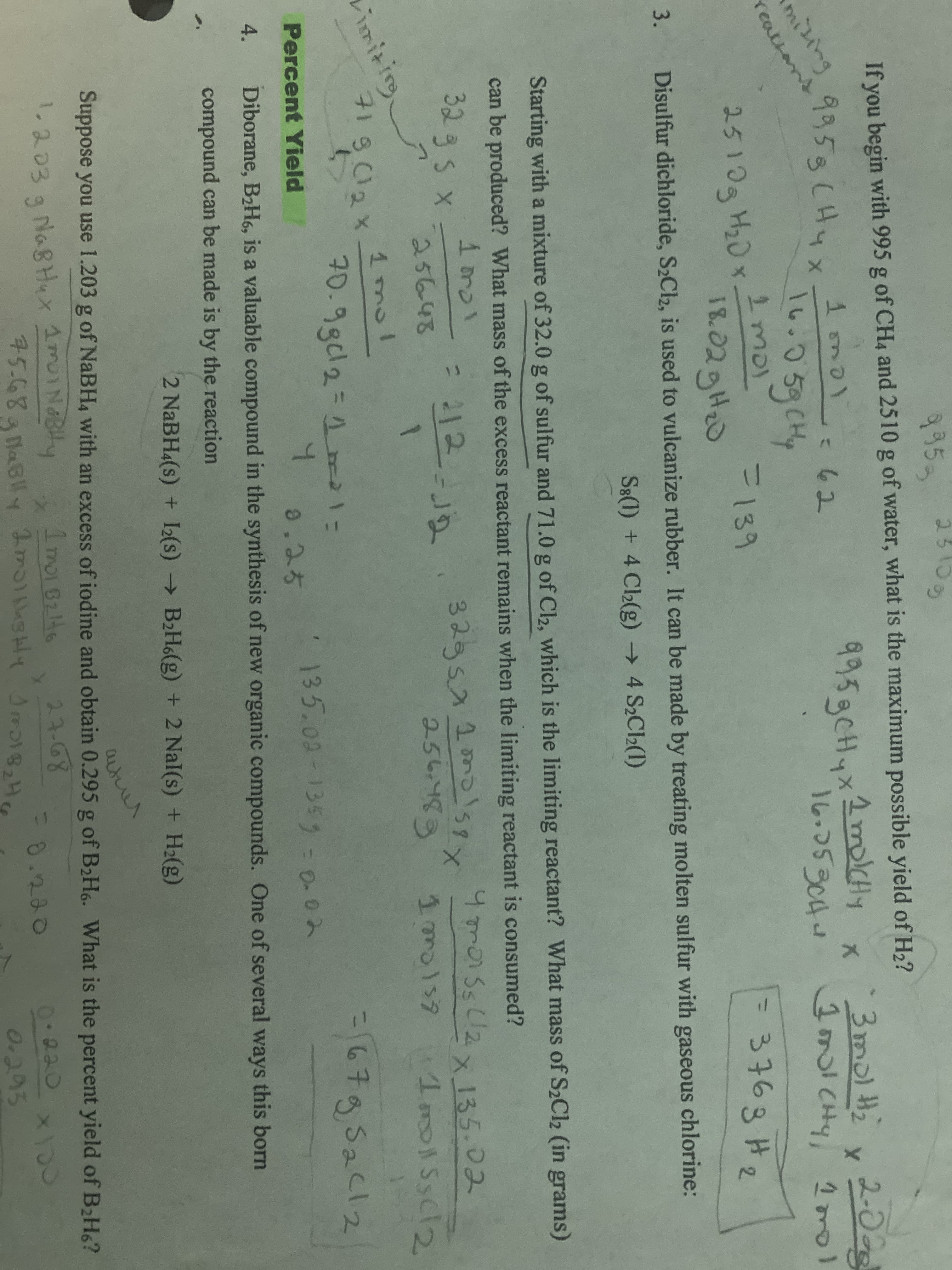9953 25100 If you begin with 995 g of CH4 and 2510 g of water, what is the maximum possible yield of H2? 995gcHyx2moCHy x 16.35304 2-0ag i y I0ICHY, 1omol 3molH2 miting reathont 9953CH4X Tu.05gcHy 2510g H20 x. 18.029H2D =139 3763 H2 3. Disulfur dichloride, S2CI2, is used to vulcanize rubber. It can be made by treating molten sulfur with gaseous chlorine: S8(1) + 4 C2(g) → 4 S2Cl2(1) Starting with a mixture of 32.0 g of sulfur and 71.0 g of Cl2, which is the limiting reactant? What mass of S2Cl2 (in grams) can be produced? What mass of the excess reactant remains when the limiting reactant is consumed? 1orol 3235X 329521m'sy 256.489 ymoissl2x 135-02 2564る 1mols9 ImolSscl2 imiting 719(12x 1 mol 70.9gcl2=D1 al: 367g52cl2 Percent Yield 135.09-1359-0-02 9.25 4. Diborane, B2H6, is a valuable compound in the synthesis of new organic compounds. One of several ways this born compound can be made is by the reaction 2 NABH4(s) + I2(s) → B2H6(g) + 2 Nal(s) + H2(g) Suppose you use 1.203 g of NABH4 with an excess of iodine and obtain 0.295 g of B2H6. What is the percent yield of B2H6? auter 1203g Na8 Hux 1moiNaBHy 1moi B2t6 75.68aMaBlY molskshl4 Am8,4, 27-68 P0.220 0-220 x130 0.295
9953 25100 If you begin with 995 g of CH4 and 2510 g of water, what is the maximum possible yield of H2? 995gcHyx2moCHy x 16.35304 2-0ag i y I0ICHY, 1omol 3molH2 miting reathont 9953CH4X Tu.05gcHy 2510g H20 x. 18.029H2D =139 3763 H2 3. Disulfur dichloride, S2CI2, is used to vulcanize rubber. It can be made by treating molten sulfur with gaseous chlorine: S8(1) + 4 C2(g) → 4 S2Cl2(1) Starting with a mixture of 32.0 g of sulfur and 71.0 g of Cl2, which is the limiting reactant? What mass of S2Cl2 (in grams) can be produced? What mass of the excess reactant remains when the limiting reactant is consumed? 1orol 3235X 329521m'sy 256.489 ymoissl2x 135-02 2564る 1mols9 ImolSscl2 imiting 719(12x 1 mol 70.9gcl2=D1 al: 367g52cl2 Percent Yield 135.09-1359-0-02 9.25 4. Diborane, B2H6, is a valuable compound in the synthesis of new organic compounds. One of several ways this born compound can be made is by the reaction 2 NABH4(s) + I2(s) → B2H6(g) + 2 Nal(s) + H2(g) Suppose you use 1.203 g of NABH4 with an excess of iodine and obtain 0.295 g of B2H6. What is the percent yield of B2H6? auter 1203g Na8 Hux 1moiNaBHy 1moi B2t6 75.68aMaBlY molskshl4 Am8,4, 27-68 P0.220 0-220 x130 0.295
Chemistry for Engineering Students
4th Edition
ISBN:9781337398909
Author:Lawrence S. Brown, Tom Holme
Publisher:Lawrence S. Brown, Tom Holme
Chapter4: Stoichiometry
Section: Chapter Questions
Problem 4.83PAE
Related questions
Question

Transcribed Image Text:9953
25100
If you begin with 995 g of CH4 and 2510 g of water, what is the maximum possible yield of H2?
995gcHyx2moCHy x
16.35304
2-0ag
i y
I0ICHY, 1omol
3molH2
miting
reathont
9953CH4X
Tu.05gcHy
2510g H20 x.
18.029H2D
=139
3763 H2
3. Disulfur dichloride, S2CI2, is used to vulcanize rubber. It can be made by treating molten sulfur with gaseous chlorine:
S8(1) + 4 C2(g) → 4 S2Cl2(1)
Starting with a mixture of 32.0 g of sulfur and 71.0 g of Cl2, which is the limiting reactant? What mass of S2Cl2 (in grams)
can be produced? What mass of the excess reactant remains when the limiting reactant is consumed?
1orol
3235X
329521m'sy
256.489
ymoissl2x 135-02
2564る
1mols9
ImolSscl2
imiting
719(12x
1 mol
70.9gcl2=D1 al:
367g52cl2
Percent Yield
135.09-1359-0-02
9.25
4.
Diborane, B2H6, is a valuable compound in the synthesis of new organic compounds. One of several ways this born
compound can be made is by the reaction
2 NABH4(s) + I2(s) → B2H6(g) + 2 Nal(s) + H2(g)
Suppose you use 1.203 g of NABH4 with an excess of iodine and obtain 0.295 g of B2H6. What is the percent yield of B2H6?
auter
1203g Na8 Hux 1moiNaBHy
1moi B2t6
75.68aMaBlY molskshl4 Am8,4,
27-68
P0.220
0-220
x130
0.295
Expert Solution
This question has been solved!
Explore an expertly crafted, step-by-step solution for a thorough understanding of key concepts.
This is a popular solution!
Trending now
This is a popular solution!
Step by step
Solved in 3 steps with 3 images

Recommended textbooks for you

Chemistry for Engineering Students
Chemistry
ISBN:
9781337398909
Author:
Lawrence S. Brown, Tom Holme
Publisher:
Cengage Learning


Chemistry
Chemistry
ISBN:
9781305957404
Author:
Steven S. Zumdahl, Susan A. Zumdahl, Donald J. DeCoste
Publisher:
Cengage Learning

Chemistry for Engineering Students
Chemistry
ISBN:
9781337398909
Author:
Lawrence S. Brown, Tom Holme
Publisher:
Cengage Learning


Chemistry
Chemistry
ISBN:
9781305957404
Author:
Steven S. Zumdahl, Susan A. Zumdahl, Donald J. DeCoste
Publisher:
Cengage Learning

Chemistry: An Atoms First Approach
Chemistry
ISBN:
9781305079243
Author:
Steven S. Zumdahl, Susan A. Zumdahl
Publisher:
Cengage Learning

Chemistry by OpenStax (2015-05-04)
Chemistry
ISBN:
9781938168390
Author:
Klaus Theopold, Richard H Langley, Paul Flowers, William R. Robinson, Mark Blaser
Publisher:
OpenStax

Chemistry: The Molecular Science
Chemistry
ISBN:
9781285199047
Author:
John W. Moore, Conrad L. Stanitski
Publisher:
Cengage Learning